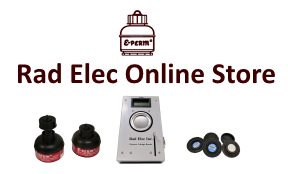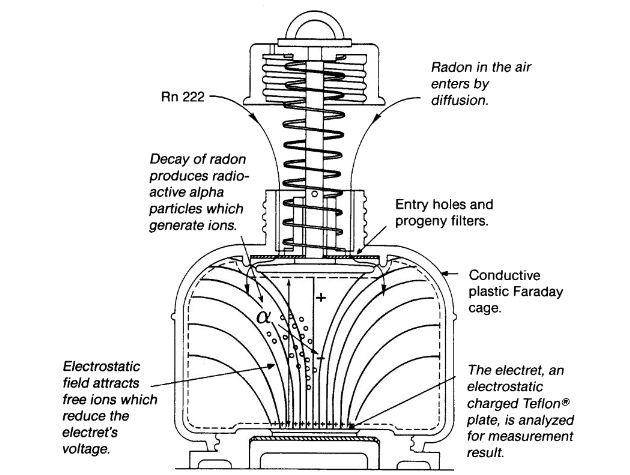
Rad Elec's Online Store is now open for business! Shop for your E-PERM® products at your convenience, at any time.
Electret Ion Chambers, although most commonly used for measuring radon in air, can nevertheless be utilized for a wide range of radon-related monitoring surveys. This includes measuring radon concentrations in water, radium concentrations in soil, and radon flux from many surfaces. We are also currently researching a technique to measure radium in water, although this is not yet ready for a public release.
 The E-PERM® is a patented passive, true integrating radon monitor that is very widely used in more than 30 countries, and is listed as the most-used device in the United States for both short- and long-term radon measurements. Only radon gas -- and not radon decay products -- diffuses through the filtered inlet into the ionization chamber's sensitive volume until the concentration of radon inside the chamber is the same as the concentration of the deployment environment. Radiation emitted by the decay of the radon (and the decay products formed from the radon inside the ionization chamber) will ionize the air.
The E-PERM® is a patented passive, true integrating radon monitor that is very widely used in more than 30 countries, and is listed as the most-used device in the United States for both short- and long-term radon measurements. Only radon gas -- and not radon decay products -- diffuses through the filtered inlet into the ionization chamber's sensitive volume until the concentration of radon inside the chamber is the same as the concentration of the deployment environment. Radiation emitted by the decay of the radon (and the decay products formed from the radon inside the ionization chamber) will ionize the air.
The positively charged electret attracts the negative ions generated by the radiation in the ionization chamber, resulting in a net decrease of the electret voltage. The positive ions are "pushed" to the wall of the ionization chamber and dissipate, due to the conductive material used in the construction of the chamber. The voltage decrease of the electret is proportional to the radon concentration and the length of the exposure period. Different configurations of ionization chambers and electrets (an overwhelming majority of which are approved for deployment by certifying agencies in the U.S. and other countries) cover virtually all ranges of interest and sensitivities in both scientific and professional fields.
These monitors are not affected by varying concentration, temperatures or humidities, and are therefore excellent for use in a variety of applications (which includes basic research, health-related measurements, indoor and outdoor radon measurements, and uranium exploration projects).
E-PERMs® can also be used to measure the concentration of radon in water. In order to accomplish this, a small water sample is placed in the bottom of a glass measurement jar. The electret ion chamber (E-PERM®) is suspended from a hook on the interior of the measurement jar's lid, which is then closed and sealed in order to make it impermeable to radon. The radon inside the water sample (located inside the sealed measurement jar) will reach equilibrium with the air inside the jar. After the desired exposure period, the jar is opened and the E-PERM® is removed and analyzed (to receive a radon-in-air concentration). By utilizing either the spreadsheet template or Radon Report Manager software, the radon-in-water calculation can be calculated during this analysis.
The procedure for measuring radium in soil is similar to that used for measuring radon in water. A soil sample, weighing about 30 grams, is dried and then humidified with 30% moisture. It is placed in a Petri dish and lowered to the bottom of the analysis jar. An E-PERM® is suspended from the top of the lid, and then the analysis jar is sealed. Radon emanated rom the sample accumulates for a period from 5 to 15 days. At the end of the desired exposure period, the E-PERM® is removed from the analysis jar, and the resulting radon concentration is calculated. Using this information, it is possible to calculate the radium concentration by assuming an emanation coefficient of 0.25. This coefficient usually valid for most soils; the manual contains exact equations in a convenient form for the user.
There are several applications for measuring radon flux. These include:
When measuring radon flux, the existing H Chamber is modified to feature a large, carbon-coated Tyvek® diffusion window. The chamber is vented by filtered outlets, so that it will not accumulate radon. When the flux monitor is placed on a radon emanating surface (whether it be the ground, granite, building materials, etc.), radon enters through the Tyvekreg; barrier and exits through the vents. The semi-equilibrium radon concentration established inside the chamber if representative of dynamic flux from the surface. Because of the equilibrium between the ground and outside environment (accomplished by the vents), the flux emanation from the ground is not disturbed. These flux monitors are equipped with a stainless steel collar that can be used to anchor them to the ground.
The electret discharge rate is a measure of the radon flux. E-PERM® flux monitors have been calibrated on the well-characterized radon flux beds at CANMET in Canada. These flux beds consist of 226Ra-bearing material, which are uranium tailings that have been extensively characterized to provide a flux of 7.7±1.1 pCi/m2/sec.